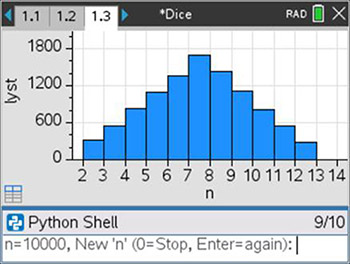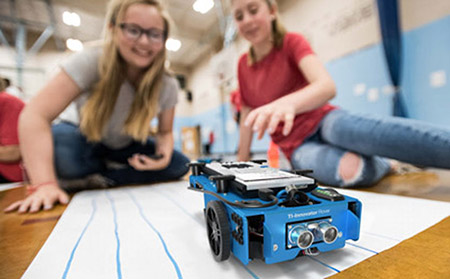7 Reasons Why Python on the TI-Nspire™ CX II Graphing Calculator Is a Must-Have for Your Classroom
This month marks the release of the latest update for the TI-Nspire™ CX II family. This update (version 5.2) includes support for Python, a significant feature that strengthens the use of TI-Nspire™ CX II graphing calculators and software in math classes.
Educators can now connect coding in Python to math, science, physical computing and robotics on a single platform. This update introduces students to one of the most popular and powerful programming languages on a familiar platform.
Here’s a list of reasons why this update is a must-have for all educators and students:
#1: Why Python?
Python is a high-level and general-purpose programming language. It’s widely used in many industries, as well as in education, and is designed to be easy to learn. Python is used in a variety of applications, including artificial intelligence, financial services and data science.
#2: TI’s support of coding in STEM
Texas Instruments (TI) graphing calculators have supported coding for nearly two decades with the TI-Basic programming language. Many students have started their programming journey through the PRGM key on their graphing calculators. The introduction of Python on the TI-Nspire™ CX II graphing calculator is the next step in this long journey of encouraging coding in all classrooms.
#3: Ease of use
The Python programming environment on the TI-Nspire™ CX II graphing calculator was designed with a focus on education. It has several features that make it easy to use by anyone new to programming.
In addition to auto-indenting and syntax highlighting, the editor is primarily menu driven. This allows for easy discovery of functions. The use of in-line prompts helps to know the expected parameters for functions. The availability of tool-tips and pick-lists helps to avoid errors by informing the user of the expected ranges.
#4: Library of built-in modules
Modules are Python’s superpower. Modules allow Python programs to be compact, as well as powerful. The Python environment on the TI-Nspire™ CX II graphing calculator has several standard Python modules: math, complex math, time and random. There are also many TI-authored modules that combine the power of Python with the versatility of the TI-Nspire™ CX II platform. The TI modules enable Python programs to interact with TI-Nspire™ CX II graphing calculator variables and applications (ti_system), plot graphs from Python programs (ti_plotlib), draw geometry graphics (ti_draw), and process images (ti_image).

#5: Connect to TI-Nspire™ apps
The TI-Nspire™ CX II platform has several built-in apps that make the calculators ideal for math and science, from middle grades through college. All Python programs on the TI-Nspire™ CX II platform can exchange data with these applications. This enables Python programs to leverage the power of these applications. An example is a statistics simulation that uses Python to generate random samples and then uses the Data & Statistics application to visualize the output.

The TI-Nspire™ Document model also enriches the instructional experience by enabling the inclusion of notes, images and other supporting material for Python programs.
#6: Portable programming platform
The Python environment on the TI-Nspire™ CX II graphing calculator does not require any additional configuration or downloads. It does not need any IT infrastructure or additional computing equipment to start using Python in your classrooms. The portability of the device also makes it suitable for use at home or even on the school bus.
#7: Physical computing
Physical computing, the ability to control physical devices like LEDs and motors through their code, is an engaging way for students to see their programs interact with the real world. The object-oriented interface to the TI-Innovator™ Hub with TI LaunchPad™ Board and TI-Innovator™ Rover — through the ti_hub and ti_rover modules — is a fun way to introduce students to robotics and working with sensors.

About the author: Harshal S. Chhaya (@hschhaya) is a systems engineer and product manager for TI’s educational STEM products. He also leads the company’s robotics outreach programs and works with partners to increase student participation in robotics competitions. Harshal enjoys using advanced engineering to make education fun and engaging for students and teachers.
Tagcloud
Archive
- 2025
- 2024
- 2023
- 2022
-
2021
- January (2)
- February (3)
- March (5)
-
April (7)
- Top Tips for Tackling the SAT® with the TI-84 Plus CE
- Monday Night Calculus With Steve Kokoska and Tom Dick
- Which TI Calculator for the SAT® and Why?
- Top Tips From a Math Teacher for Taking the Online AP® Exam
- Celebrate National Robotics Week With Supervised Teardowns
- How To Use the TI-84 Plus Family of Graphing Calculators To Succeed on the ACT®
- AP® Statistics: 6 Math Functions You Must Know for the TI-84 Plus
- May (1)
- June (3)
- July (2)
- August (5)
- September (2)
-
October (4)
- Transformation Graphing — the Families of Functions Modular Video Series to the Rescue!
- Top 3 Halloween-Themed Classroom Activities
- In Honor of National Chemistry Week, 5 “Organic” Ways to Incorporate TI Technology Into Chemistry Class
- 5 Spook-tacular Ways to Bring the Halloween “Spirits” Into Your Classroom
- November (4)
- December (1)
-
2020
- January (2)
- February (1)
- March (3)
- April (1)
- May (2)
- July (1)
- August (2)
- September (3)
-
October (7)
- Tips for Teachers in the time of COVID-19
- Top 10 Features of TI-84 Plus for Taking the ACT®
- TI Codes Contest Winners Revealed
- Best of Chemistry Activities for the Fall Semester
- Best of Biology Activities for the Fall Semester
- Best of Physics Activities for the Fall Semester
- Best of Middle Grades Science Activities
- November (1)
- December (2)
- 2019
-
2018
- January (1)
- February (5)
- March (4)
- April (5)
- May (4)
- June (4)
- July (4)
- August (4)
- September (5)
-
October (9)
- Art in Chemistry
- Which Texas Instruments (TI) Calculator for the ACT® and Why?
- Meet TI Teacher of the Month: Jessica Kohout
- Innovation in Biology
- Learning With Your Students
- A first-of-its-kind STEM strategy charts path to help educators
- #NCTMregionals Hartford 2018 Recap
- The Math Behind “Going Viral”
- Real-World Applications of Chemistry
-
November (8)
- Testing Tips: Using Calculators on Class Assessments
- Girls in STEM: A Personal Perspective
- 5 Teachers You Should Be Following on Instagram Right Now
- Meet TI Teacher of the Month: Katie England
- End-of-Marking Period Feedback Is a Two-Way Street
- #NCTMregionals Kansas City 2018 Recap
- Slope: It Shouldn’t Just Be a Formula
- Hit a high note exploring the math behind music
- December (5)
- 2017
- 2016
- 2015
